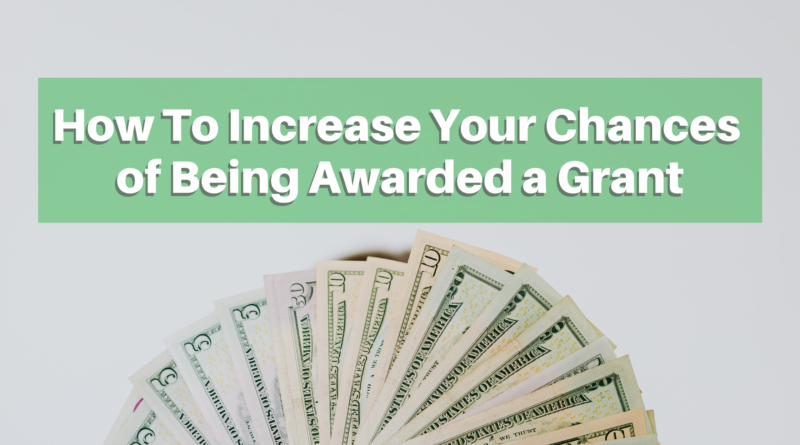How to Increase Your Chances of Being Awarded a Grant
What are your chances of being awarded a grant? On average, sources estimate that 1 in 7 applications are approved for funding. So how can you increase your chances of winning a grant? First, here are a few of the most frequent reasons a funding source would likely reject a grant proposal request:
- The request does not align with the funder’s donation parameters and interests.
- The applicant didn’t follow the application guidelines & requirements. As a result, the grant proposal was prevented from even being considered.
- Though potentially eligible, the funding source had other funding priorities at the time the request was made.
Here are the key takeaways to help you succeed:
- Ensure your grant proposal aligns with the funder’s donation parameters and interests.
- Follow the application guidelines and requirements to the letter!
- Apply as early as possible in order for your proposal to be given priority and ultimately awarded the grant funding you requested.
But did you know there other ways to get your grant proposal ‘to the top of the list’ of proposals being considered? Below, are some great tips that will increase your odds of winning a grant!
9 Tips to Help Secure Upcoming Funding Opportunities
1) Target Your Funders
There are many different types of funding sources, but which funding source is best for you? In 2017, a study showed what percentage of applicants actually were awarded grant funding:
- Private foundations (75%)
- Community foundations (63%)
- Corporations (52%)
- State Government (42%)
- Local Government (36%)
- Federal Government funding (33%)
- Other funding sources (13%)
Private foundations continue to be the most likely funding sources for most respondents. Of those surveyed who received funding, private foundations were the source from which grant seekers would most likely receive the award they applied for. Although government grants are still “big money,” organizations should keep in mind you likely have less than a 50% chance of winning a grant.
Pro Tip: If your organization is small (budget under $1 million), new (in existence for less than five years), or has never received a grant larger than $45,000, smaller foundations will be your best funding sources.
2) Submit at Least Three Grant Applications
The more applications you submit, the greater the likelihood of being awarded a grant. Applying for at least three grant applications increased the frequency of winning an award to 89%! 2017 data collected from U.S. nonprofits revealed the following results when submitting grant fund applications:
- 1 Application: 63% of respondents won at least one grant.
- 2 Applications: 75% of respondents won at least one grant.
- 3 to 5 Applications: 89% of respondents won at least one grant.
- 6 to 10 Applications: 96% of respondents won at least one grant.
- 11 to 20 Applications: 98% of respondents won at least one grant.
- 21 to 30 Applications: 99% of respondents won at least one grant.
You can see that submitting three or more grant applications to various funders is the ‘magic number’ if you want success when applying for grants. So don’t be afraid of your first rejection; instead, use it as part of your ‘learning curve’ to help you improve your likelihood of success the next time!
3) Don’t Rush the Research
Compiling a grant application takes time. On average, grant research usually takes more than three days per grant for 40% of grant seekers. Making a plan for – and the writing of – the grant application usually takes more than five days. This is an important process that you should not rush. After all, if a foundation is willing to fund your project, you can’t expect them to blindly award you funds. You need to show them the facts!
You could also consider hiring a professional grant writer for help with the research, development and overall polishing of your grant application. Grant writers have experience in writing winning grant applications for a wide variety of grants, including state and local governments, foundation and corporate grant opportunities, individual contracts and all federal grant-making agencies.
4) Meet the Eligibility Requirements
If you apply for a grant that has strict eligibility requirements and your organization doesn’t meet them, your application will not receive the funding it requests. Sometimes, it’s tempting to think that the funder might ‘bend’ their eligibility requirements after they read about the great work of your organization. The reality is most funders receive so many grant applications, they’re more likely to look for reasons to eliminate an application from consideration. If your application does not pass the check for basic eligibility requirements, IT WON’T BE READ! One simple piece of advice, “if you don’t qualify, don’t apply.”
5) Submit a Compliant Proposal
A grant application has two parts, the substantive content and the packaging of the application (including formatting). Both parts must adhere to the funder’s guidelines to be compliant.
- A funder’s application guidelines will usually tell you how to structure the proposal. This includes major headings as well as topic components.
- On the packaging side, for example, did the funder say to “submit a 14-page proposal with 11-pt Times New Roman font, double-spaced text, with 1-inch margins, on letter size (8 1/2 x 11 inch) paper?” Did the proposal you submitted meet all of these requirements? Incorrect formatting of your proposal will be a sure sign to the funder that you haven’t followed their submission guidelines.
If you don’t follow the directions, you can bet the funder will not read your proposal. Formatting checklists come in handy for this kind of cross-check.
6) Make Sure Your Proposal is Coherent and Readable
If you submit a poorly written proposal, your application will be less likely to receive funding for two reasons:
- The funder may not be able to figure out what the goal is that you’re proposing to achieve or how you intend to accomplish that goal.
- A poorly written proposal will likely be unclear in its objectives and is something that may make the funder question whether your proposal would be a good ‘investment.’
Even if you have met all of the application guidelines, your application may not make the ‘short list’ for further review if there are spelling or grammar errors. If you don’t have strong writing skills, or if you need to prepare a proposal in a language in which you have little or no familiarity, it is essential to find an editor who can work with you to polish the text to make it as clear as possible.
7) Don’t Submit a ‘Generic’ Proposal
Submitting a proposal only made up of text copied and pasted from other proposals is unlikely to be successful being awarded. While re-using text in more than one proposal can be acceptable, keep in mind that the requirements and interests differ for each application. If you don’t tailor each proposal to meet those requirements, your proposal will not be appealing for the potential grant funder to consider.
8) Prove You are Responsible with Money
Is your organization structurally and fiscally sound? Sometimes the best-written grant proposal is rejected because the funder had serious questions about the organization’s capacity to carry out the scope of the work described in the proposal. Funders will ask for a variety of documentation, including previous tax returns and financial records, so make sure these records are up to date and in compliance.
9) Know Your Strengths
Are you seeking general operating or start-up funding? As opposed to program funding, these types of grants are generally tougher to get funded. Grant proposals have a greater chance of being awarded if they can offer a compelling solution to a well-documented community problem. It’s important to remember that grant funds awarded are most likely to be utilized by an organization to provide needed resources needed to help their community – not to help the organization itself to ‘stay afloat’ or ‘get off the ground.’ Make sure you have an activity, service, project or program goal in mind intended to benefit others.
Where to Start Your Grant Journey:

Free grant resources are available online to help with you to prepare and submit grant applications, to help you increase your chances of being awarded. To help you get started, we recommend you view sample grants, funding documents and grant application toolkits. It is also important to learn the glossary of funding terms; especially the terms LOI (Letter of Intent) and RFP (Request for Proposal, aka the application).
Looking for grants? With close to 8,000 grants currently available, GrantWatch.com is the leading grant listing directory. Upgrade to a MemberPlus+ subscription to view full grant details, including eligibility criteria and application information. For more information, you can also visit the GrantWatch FAQ page or check out the top 20 GrantWatch features here.
Good luck with your grant application. We hope these tips help get you the grant you’re seeking!

